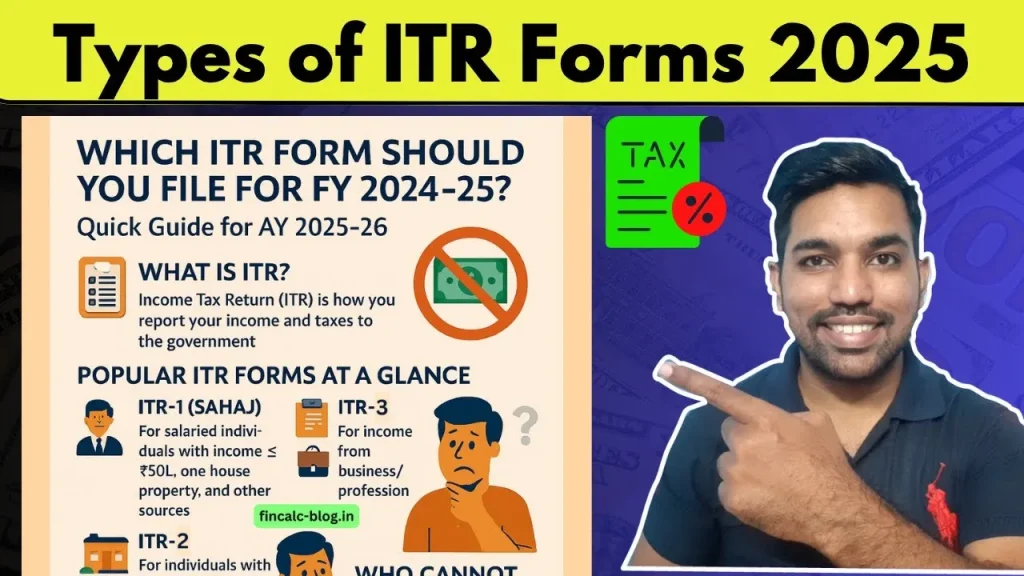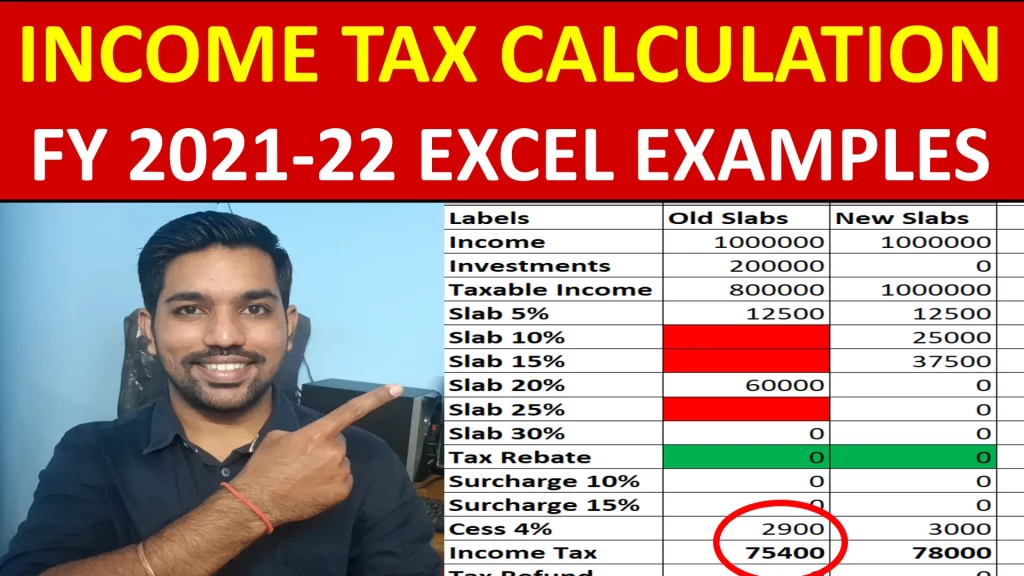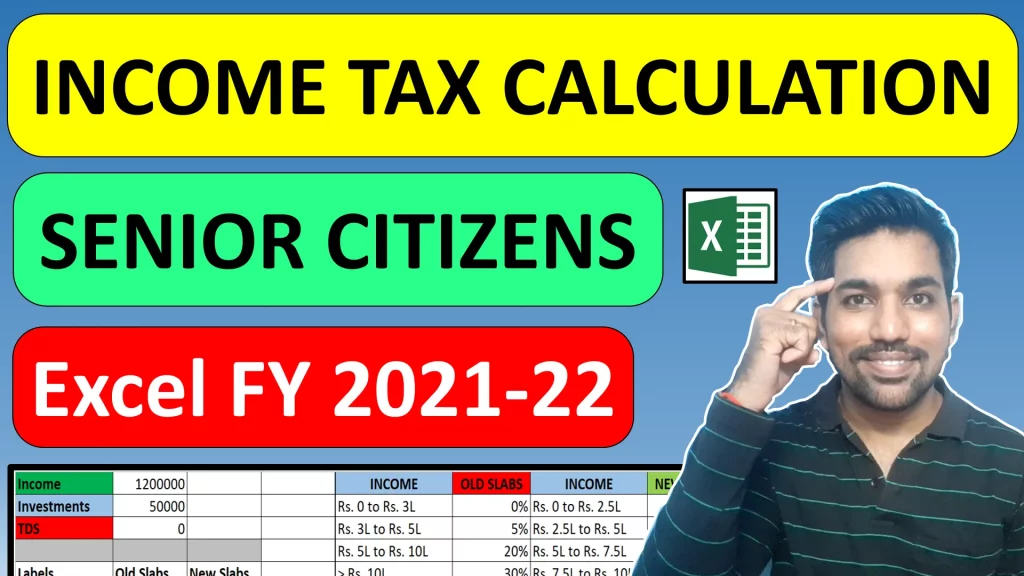This article will provide you the Types of ITR Forms and which ITF form you should select while filing Income Tax Return. ITR-1 is usually for salaried individuals with income less than 50 lakh in a financial year and not more than 1 house property. If you have gains short term or long term capital gains, or have more than 1 house property, or have salary income more than 50 lakh in financial year, than you should file ITR-2 form.
- WATCH VIDEO: Types of ITR Forms
- ITR-1 (Sahaj): The Simplest Form for Salaried Individuals
- ITR-2: For High Earners, Multiple Properties, and Capital Gains
- ITR-3: The Form for Business Owners and Professionals
- ITR-4 (Sugam): Simplified for Presumptive Taxation
- Key Differences and Comparison: Choosing Your ITR Form
- Download Income Tax Calculator in Excel
- Frequently Asked Questions (FAQ) about ITR Filing
WATCH VIDEO: Types of ITR Forms

As seen, in above video, ITR-1 to ITR-4 are explained for individuals for India.
Let us now understand more about different Types of ITR Forms:
ITR-1 (Sahaj): The Simplest Form for Salaried Individuals
ITR-1, also known as Sahaj, is the most commonly used and simplest ITR form. It is designed for individuals with relatively straightforward income sources.
Who can use ITR-1?
- Individuals who are resident in India (not a Resident Not Ordinarily Resident (RNOR) or Non-Resident Indian (NRI)).
- Individuals with a total income up to ₹50 lakh for the financial year.
What income sources does ITR-1 cover?
- Salary/Pension: Income received from employment or retirement benefits.
- Income from One House Property: This includes rental income from a single property or interest paid on housing loans for a single self-occupied or rented property.
- Income from Other Sources: This category typically includes:
- Interest income from savings accounts.
- Interest income from fixed deposits (FDs) and recurring deposits (RDs).
- Family pension.
- Income from other minor sources as specified.
Who cannot use ITR-1?
- Individuals with income exceeding ₹50 lakh.
- Individuals who are directors in a company.
- Individuals with income from more than one house property.
- Individuals with income from business or profession.
- Individuals with agricultural income exceeding ₹5,000.
- Individuals with foreign assets or foreign income.
- Individuals claiming relief under Section 90/90A/91 (relating to double taxation relief).
- Individuals who have income from gambling, lottery, or horse racing.
ITR-1 is primarily suited for salaried employees or pensioners who have a single house property and basic interest income.
How to File ITR-1 Online Video

ITR-2: For High Earners, Multiple Properties, and Capital Gains
ITR-2 is a more comprehensive form than ITR-1, designed for individuals whose income sources are more diverse or whose total income exceeds the limit for ITR-1.
Who can use ITR-2?
- Individuals who are resident in India, RNOR, or NRI.
- Individuals with a total income exceeding ₹50 lakh (thus ineligible for ITR-1).
- Individuals who cannot use ITR-1 due to specific income types or other criteria, but do not have income from business or profession.
What income sources does ITR-2 cover?
ITR-2 includes all income sources covered under ITR-1, along with additional categories:
- Income from More Than One House Property: This is a key differentiator from ITR-1.
- Capital Gains: This is a significant inclusion for ITR-2 users. It covers income from:
- Sale of mutual funds.
- Sale of property (land, building).
- Sale of other capital assets.
- Capital gains from cryptocurrency. If cryptocurrency trading/investing is not considered a business, then ITR-2 is the appropriate form for reporting capital gains.
- Income from Foreign Assets/Sources: Applicable for individuals who hold assets outside India or derive income from foreign countries (e.g., NRIs or residents with foreign income).
- Agricultural Income exceeding ₹5,000.
- Income from Lottery, Gambling, Horse Racing.
- Being a director in a company.
Who cannot use ITR-2?
- Individuals with income from a business or profession. This is the primary exclusion. If you have income from freelancing, consulting, or any other business activity, you must use ITR-3 or ITR-4 (under presumptive taxation).
ITR-2 is suitable for salaried individuals with significant capital gains, multiple properties, or international income/assets, who are not engaged in business or professional activities.
How to File ITR-2 Online Video

ITR-3: The Form for Business Owners and Professionals
ITR-3 is the form specifically designed for individuals and Hindu Undivided Families (HUFs) who have income from a business or profession. It is the most comprehensive form for individual taxpayers.
Who can use ITR-3?
- Individuals and HUFs with income from business or profession.
- Individuals and HUFs who are partners in a firm.
- Individuals who have all income sources covered in ITR-2, plus business/professional income.
What income sources does ITR-3 cover?
ITR-3 covers all income sources included in ITR-2, in addition to:
- Income from Business: This includes income generated from any trade, commerce, or manufacturing activity. Examples:
- Manufacturing and selling products.
- Operating a retail store.
- Any other commercial enterprise.
- Income from Profession: This includes income earned by individuals practicing a specific profession. Examples:
- Freelancers (writers, designers, developers).
- Consultants (financial, management, IT).
- Doctors, lawyers, architects, chartered accountants.
- Any individual earning income from a notified profession.
- Income from Cryptocurrency (if treated as business income): If your cryptocurrency trading or investing activities are substantial and regular enough to be classified as a business, then ITR-3 would be the correct form to report this income.
- Income from being a partner in a firm (e.g., salary, interest, commission from the firm).
Key point: If you are a salaried employee and also run a side business or work as a freelancer, you will likely need to file ITR-3.
ITR-4 (Sugam): Simplified for Presumptive Taxation
ITR-4, also known as Sugam, is a simplified form for individuals, HUFs, and Partnership Firms (other than LLPs) who opt for the presumptive taxation scheme. This scheme is designed to reduce the compliance burden for small taxpayers by allowing them to declare income at a presumptive rate, without the need to maintain detailed books of accounts.
Who can use ITR-4?
- Individuals, HUFs, and Partnership Firms (other than LLPs).
- Resident individuals only (not applicable for RNOR or NRI).
- Total income is up to ₹50 lakh.
- Individuals with business or professional income under the presumptive taxation scheme.
What income sources does ITR-4 cover?
ITR-4 includes income sources covered under ITR-1, along with:
- Business Income under Section 44AD: For small businesses, income is presumed at 6% of the turnover (for digital transactions) or 8% of the turnover (for other transactions).
- Professional Income under Section 44ADA: For specified professionals, income is presumed at 50% of the gross receipts.
- Income from Plying, Hiring or Leasing Goods Carriages under Section 44AE: For small transport businesses.
Examples of taxpayers who might use ITR-4:
- Small shopkeepers.
- Freelancers (designers, content creators) or consultants whose gross receipts are below the threshold and who opt for presumptive taxation.
- Individuals with income from online sources like websites (e.g., Google AdSense), or YouTube, provided they opt for the presumptive scheme and their turnover/gross receipts are within limits.
Who cannot use ITR-4?
- Individuals whose total income exceeds ₹50 lakh.
- Individuals who have capital gains.
- Individuals who have income from more than one house property.
- Individuals with foreign assets or foreign income.
- Individuals who have income from lottery, gambling, etc.
- Individuals who do not opt for the presumptive taxation scheme for their business/professional income.
ITR-4 is a beneficial option for small businesses and professionals who want to simplify their tax filing by avoiding complex accounting, provided they meet the specified conditions.
A Quick Glance at Other ITR Forms (ITR-5, ITR-6, ITR-7)
- ITR-5: For firms, LLPs (Limited Liability Partnerships), AOPs (Association of Persons), BOIs (Body of Individuals), etc.
- ITR-6: For companies other than those claiming exemption under Section 11 (e.g., charitable trusts).
- ITR-7: For persons including companies required to furnish return under sections 139(4A) or 139(4B) or 139(4C) or 139(4D) (e.g., charitable trusts, political parties, universities, etc.).
These forms are not applicable to individual taxpayers.
Key Differences and Comparison: Choosing Your ITR Form
Selecting the right ITR form is crucial. A wrong choice can lead to rejection of your return or even penalties. The primary factors to consider are your income sources and total income.
Here’s a comparison table to help you distinguish between ITR-1, ITR-2, ITR-3, and ITR-4:
| Feature/Form | ITR-1 (Sahaj) | ITR-2 | ITR-3 | ITR-4 (Sugam) |
| Applicable To | Resident Individual | Individual, HUF (Resident, RNOR, NRI) | Individual, HUF | Resident Individual, HUF, Partnership Firm (other than LLP) |
| Total Income Limit | Up to ₹50 Lakh | No limit | No limit | Up to ₹50 Lakh |
| Salary/Pension | Yes | Yes | Yes | Yes |
| One House Property | Yes | Yes | Yes | Yes |
| Multiple House Properties | No | Yes | Yes | No |
| Other Sources (Interest, etc.) | Yes | Yes | Yes | Yes |
| Capital Gains | No | Yes (from shares, mutual funds, property, crypto) | Yes | No |
| Business/Profession Income | No | No | Yes | Yes (only if opting for Presumptive Taxation) |
| Presumptive Taxation | Not Applicable | Not Applicable | No (if opting for presumptive taxation, use ITR-4) | Yes (Section 44AD, 44ADA, 44AE) |
| Foreign Assets/Income | No | Yes | Yes | No |
| Director in a Company | No | Yes | Yes | No |
| Unlisted Equity Shares | No | Yes | Yes | No |
| Agricultural Income (>₹5k) | No | Yes | Yes | No |
| Lottery/Gambling Income | No | Yes | Yes | No |
This table serves as a quick reference. Always confirm your eligibility based on the detailed criteria before finalizing your ITR form choice.
Download Income Tax Calculator in Excel
You can download the Income Tax Calculator in Excel using below buttons:
Frequently Asked Questions (FAQ) about ITR Filing
What is the difference between Financial Year and Assessment Year?
The Financial Year (FY) is when income is earned (e.g., FY 2024-2025: April 1, 2024, to March 31, 2025). The Assessment Year (AY) is when that income is assessed and taxed (e.g., AY 2025-2026 for FY 2024-2025).
What is the deadline for filing ITR for FY 2024-2025 (AY 2025-2026)?
The usual deadline is July 31st, 2025. However, for AY 2025-2026, it has been extended to September 15th, 2025. It’s always best to file by July or August to avoid last-minute issues.
Who needs to file an Income Tax Return?
If your gross total income exceeds the basic exemption limit, you must file. Under the Old Tax Regime, it’s ₹2.5 lakh (for those under 60). Under the New Tax Regime, it’s ₹3 lakh for all individuals, even if your tax liability becomes zero due to Section 87A rebate.
Which ITR form should a salaried person with only salary and interest income use?
If your total income is up to ₹50 lakh and you have income from salary/pension, one house property, and other sources like interest, you should use ITR-1 (Sahaj).
I have capital gains from selling shares. Which ITR form applies to me?
If you have capital gains from shares, mutual funds, property, or cryptocurrency (not as a business), and you do not have business or professional income, you should use ITR-2.
I am a freelancer and my income is below ₹50 lakh. Can I use ITR-4?
Yes, if you are a resident individual and opt for the presumptive taxation scheme (where your profit is presumed as a percentage of your gross receipts/turnover), and your total income is up to ₹50 lakh, you can use ITR-4 (Sugam).
What if I have both salary income and income from a small business?
If your business income is substantial and you do not opt for presumptive taxation, or if you have income from capital gains, you will likely need to use ITR-3. If your business income falls under the presumptive taxation scheme and your total income is below ₹50 lakh, you might use ITR-4.
What if my income is from more than one house property?
If you have income from more than one house property, you cannot use ITR-1. You would need to use ITR-2 (if no business/professional income) or ITR-3 (if you also have business/professional income).
Can NRIs file ITR-1 or ITR-4?
No, ITR-1 and ITR-4 are only for resident individuals. NRIs (Non-Resident Indians) must file ITR-2 or ITR-3 depending on their income sources.
Where can I find tools to help me calculate my income tax?
Websites like FinCalC TV (fincalc-blog.in) offer online income tax calculators for the current financial year and also provide downloadable Excel calculators for comprehensive tax planning.
Some more Reading:
- How to Save STCG Tax using Tax Rebate 87A
- ITR-2 Filing Explained with Video
- SIP vs SWP Which is right for you
Save Home Loan Interest Amount!
Use Home Loan Excel Calculator that will help you to Save Interest Amount on Home Loan EMI.
Click below button to download Home Loan EMI and Prepayment Calculator in Excel:
Watch how Home Loan Calculator in Excel Works
Income Tax Calculator App – FinCalC
For Income Tax Calculation on your mobile device, you can Download my Android App “FinCalC” which I have developed for you to make your income tax calculation easy.
What you can do with this mobile App?
- Calculate Income Tax for FY 2025-26 and previous FY 2024-25
- Enter estimated Investments to check income tax with Old and New Tax Regime
- Save income tax details and track regularly
- Know how much to invest more to save income tax
- More calculators including PPF, SIP returns, Savings account interest and lot more

Use Popular Calculators:
- Income Tax Calculator
- Home Loan EMI Calculator
- SIP Calculator
- PPF Calculator
- HRA Calculator
- Step up SIP Calculator
- Savings Account Interest Calculator
- Lump sum Calculator
- FD Calculator
- RD Calculator
- Car Loan EMI Calculator
- Bike Loan EMI Calculator
- Sukanya Samriddhi Calculator
- Provident Fund Calculator
- Senior Citizen Savings Calculator
- NSC Calculator
- Monthly Income Scheme Calculator
- Mahila Samman Savings Calculator
- Systematic Withdrawal Calculator
- CAGR Calculator
I’d love to hear from you if you have any queries about Personal Finance and Money Management.
JOIN Telegram Group and stay updated with latest Personal Finance News and Topics.
Download our Free Android App – FinCalC to Calculate Income Tax and Interest on various small Saving Schemes in India including PPF, NSC, SIP and lot more.
Follow the Blog and Subscribe to YouTube Channel to stay updated about Personal Finance and Money Management topics.





